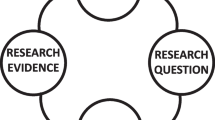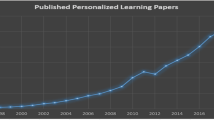Abstract
Efficient, effective and intuitive access to multimedia information is essential for business, education, government and leisure. Unfortunately, interface design typically does not account for users with disabilities, estimated at 40 million in America alone. Given broad societal needs, our community has a social responsibility to provide universal designs that ensure efficient and effective access for all to heterogeneous and increasingly growing repositories of global information. This article describes information access functions, discusses associated grand challenges, and outlines potential benefits of technologies that promise to increase overall accessibility and success of interaction with multimedia. The article concludes by projecting the future of multimodal technology via a roadmap of multimodal resources, methods, and systems from 2003 through 2006.
Similar content being viewed by others
References
André E, Rist T, Müller, J (1999) Employing AI methods to control the behavior of animated interface agents. Applied Artif Intell 13:415–448
Boykin S, Merlino A (Feb 2000) Machine learning of event segmentation for news on demand. Commun ACM 43(2):35–41
Bruce I, McKennell A, Walker E (1991) Blind and partially sighted adults in britain: the RNIB survey. HMSO, London
Cowan N (2001) The magical number 4 in short-term memory: a reconsideration of mental storage capacity. Brain Behav Sci 24(1):87–114
Jaquith J (1996) The role of short term memory on academic achievement. Retrieved May 2002 from http://www.nacd.org
Johnson WL, Rickel J (1998) Steve: an animated pedagogical agent for procedural training in virtual environments. SIGART Bull 8:16–21
Jameson A, Schäfer R, Weis T, Berthold A, Weyrath T (1999) Making systems sensitive to the user’s changing resource limitations. Knowl Syst 12:413–425
Jameson A (2002) Intelligent user interfaces: closing the usability gap. In: Colloquium on the Future of Human–Computer Interaction at the Center for Human–Computer Communication, Portland, Oregon. http://207.98.103.220:7070/ramgen/drivee/jameson_02apr26.rm. Cited 20 February 2003
Light M, Maybury M (May 2002) Personalized multimedia information access: ask questions, get personalized answers. Comm ACM 45(5): 54–59
Mani I (2001) Automated text summarization. John Benjimans, Amsterdam
Mani I, Maybury M (eds) (1999) Advances in automatic text summarization. MIT Press, Cambridge, Mass.
Maybury M, Merlino A, Morey D (1997) Broadcast news navigation using story segments. In: ACM international multimedia conference, Seattle, Wash., 8–14 November 1997. ACM Press, New York
Maybury M (2000) News on demand: introduction. Commun ACM 43(2):32–34
Maybury M (2000) Ask questions, get answers. In: First international conference on adaptive hypertext ’00, Trento, Italy, 29 August 29 2000. http://AH2000.itc.it/Maybury-AH2000.pdf. Cited 21 February 2003
Maybury M (2001) Extraction of knowledge from unstructured text. http://www.mitre.org/resources/centers/it/maybury/information_access_tutorial.ppt. Cited 23 February 2003
Maybury M, Martin J-C (eds) (2002) Working notes of the workshop on multimodal resources and multimodal systems evaluation. In: Third international conference on language resources and evaluation (LREC). Las Palmas, Canary Islands, Spain, 1 June 2002
Maybury MT, Wahlster W (eds) (1998) Readings in intelligent user interfaces. Morgan Kaufmann, San Francisco, Calif.
Merlino A, Maybury M (1999) An empirical study of the optimal presentation of multimedia summaries of broadcast news. In: Mani I, Maybury M (eds) Automated text summarization. MIT Press, Cambridge, Mass.
Miller G (1956) The magic number seven, plus or minus two: some limits of our capacity for processing information. Psychol Rev 63:81–97
National Center for Health Statistics (2003) www.cdc.gov/nchs/nhis.htm Cited 20 February 2003
Oviatt S (1997) Multimodal interactive maps: Designing for human performance. Hum–Comput Interaction 12:93–129
Sperling G (1960) The information available in brief visual presentations. Psychol Monogr 74:1–29
Umansky D (ed) (2001) Medizin Guidebook 8(1):2
Vanderheiden GC (1988) Overview of the basic selection techniques for augmentative communication: past and future. In: Berstein LE (ed) The vocally impaired: clinical practice and research. Grune and Stratuon, Philadeplphia
Voorhees E (2001) An overview of the TREC 2001 question answering track. http://trec.nist.gov/pubs/trec10/papers/qa10.pdf. Cited 20 February 2003
Bordegoni M, Faconti G, Feiner S, Maybury MT, Rist T, Ruggieri S, Trahanias P, Wilson M (1997) A Standard Reference Model for Intelligent Multimedia Presentation Systems. In: Computer Standards & Interfaces 18(6,7) December 1997, North-Holland, pp 477–496. www.dfki.uni-sb.de/∼rist/csi.html
Author information
Authors and Affiliations
Corresponding author
Rights and permissions
About this article
Cite this article
Maybury, M. Universal multimedia information access. UAIS 2, 96–104 (2003). https://doi.org/10.1007/s10209-002-0043-5
Published:
Issue Date:
DOI: https://doi.org/10.1007/s10209-002-0043-5




